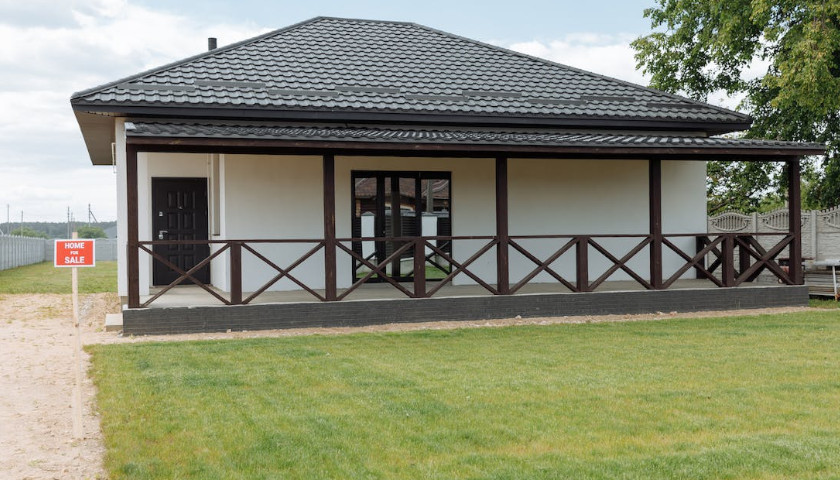by E.J. Antoni
Which direction is the housing market going? To discern that requires understanding exactly where we are now, and how we got here. These are valuable points to ponder since Americans’ homes are often their most valuable asset and largest store of wealth, and those homes are hemorrhaging.
All the data on housing indicates we’re firmly in a recession. Building permits for housing, an indicator of future construction, have been trending down all year, while the number of homes on which construction has started has trended down since April. Sales of new homes have fallen 39% this year, and sales of existing homes are also declining, indicating a broader market trend.
Pending sales too are declining, which hints that the decline will continue.
 The lack of demand at today’s prices and interest rates is evident from the recent decline in home prices. For those who build homes, however, their costs are not going down, and profit is being squeezed. It is no wonder that home builders’ confidence has collapsed this year, falling 45%.
The lack of demand at today’s prices and interest rates is evident from the recent decline in home prices. For those who build homes, however, their costs are not going down, and profit is being squeezed. It is no wonder that home builders’ confidence has collapsed this year, falling 45%.
Fewer homes are being built and sold, fewer people can afford to build or buy homes and prices are now falling. There is no better indication of recession than that summary.
How we got here is a lesson on short-sightedness and government interference.
People were enticed to take on larger mortgages by the Federal Reserve’s unreasonably low rates, which gave buyers access to record-breaking levels of cash and — more dangerously — leverage. The ensuing bidding wars sent home prices to the moon.
But the Fed announced “last call” on that party when it started raising rates. Now the market is sobering up, and things are going sideways in a hurry.
As interest rates rise, buyers cannot afford the same sized loans. Even though rates are still below their long-run average, they are climbing from record lows, so the effect of the increase is dramatic and devastating.
Interest charges on a median-priced home have risen so much since President Joe Biden took office that the monthly payment on the same mortgage has roughly doubled — and that does not even include the massive home price increase over that same time.
Interest-rate increases on top of home-price appreciation combined to reduce homeownership affordability to its lowest level in at least 16 years, when the Federal Reserve Bank of Atlanta created the metric. Since January 2021, homeownership affordability is down 32%.
Too many homes are simply too unaffordable for too many people at today’s prices. That is why prices are declining, and will continue to do so, even as a collapse in homebuilding squeezes supply.
Worse, an increasing number of overleveraged people who did not put enough money down on their home purchase may find themselves underwater, owing more than their home is worth. For those with adjustable-rate mortgages, their monthly payments are primed to explode once the rate adjustments begin, usually two to five years from the loan’s start.
Both default and delinquency rates are rising and are poised to go higher. For those with ample cash on hand, this presents great buying opportunities. For the overleveraged, a weak housing market further constrains their already tight budgets.
Will prices continue falling or have things stabilized? Now we come to the wild card: the Federal Reserve.
The central bank has become nothing if not unpredictable. The very next meeting after saying a 75-basis-point rate hike was off the table, that’s exactly what the nation got, with two more immediately thereafter. The Fed promised to start selling off its mortgage-backed securities (MBS), but now has no plans to do so.
Currently, the Fed seems content to let home prices slowly decline. That could very easily change, however, just as the Fed turned on its heels after describing inflation as transitory. If the Fed begins to sell its $2.7 trillion in MBS, the availability of mortgages and homes will dry up fast as interest rates skyrocket and home prices collapse.
In that scenario, many broke Americans will discover just how in debt they are and how little liquidity they have when forced to sell their homes at fire-sale prices.
Housing recessions offer a powerful reminder about leverage and risk that is worth quoting in full: “If you aren’t in debt, you can’t go broke and can’t be made to sell, in which case “liquidity” is irrelevant. But a leveraged firm may be forced to sell, lest fast-accumulating losses put it out of business. Leverage always gives rise to this same brutal dynamic, and its dangers cannot be stressed too often.”
– – –
E.J. Antoni is a research fellow for regional economics in The Heritage Foundation’s Center for Data Analysis and a senior fellow at Committee to Unleash Prosperity.
The views and opinions expressed in this commentary are those of the author and do not reflect the official position of the Daily Caller News Foundation.





